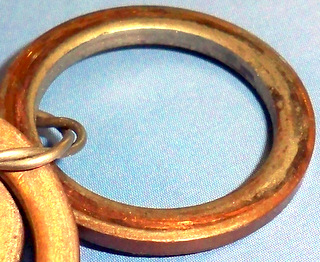Gaskets tell a story about sealing surfaces, but all too often they are discarded without giving them a chance to tell their story. Whenever joints come together the contact (faying) surfaces conform and the joint functions properly; or joints can leak, move about, loosen, wear, and cause problems. Gaskets, and washers acting as gaskets, seal by embeding into imperfections in the faying surfaces -- to a point. You can prevent problems by inspecting gaskets and surfaces to see how they are doing.
Metal gaskets provide clues to the condition of the sealing surface
The spark plug gasket above was leaking at the upper right hand corner. I would suspect that the sealing surface on the cylinder is damaged and leakage may continue even with a new gasket. Close monitoring for leakage after a test run and for the first few operations would be prudent. A leaking spark plug gasket interrupts the heat path causing the spark plug to operate hotter and possibly cause pre-ignition. Gas leakage also erodes the boss resulting in even more leakage if not corrected. |
| Spark Plug Gasket -- leakage at upper right corner |
Gaskets tell you if they are overtightened
 |
| Spark Plug Gasket - Deformed from excessive torque. |
Spark plug gasket cupping from overtightening. Place gasket on flat surface and push on edge to see if it is flat or warped. Axial displacements around the inside edge
 |
| Crushed washer -- too much torque or washer material is too weak |
Typical Joint Imperfections:
| Silicone rubber used on exhaust gasket to embed into imperfections |
- Improper surface finish -- too rough. Lapping surfaces might help
- Damaged surfaces -- scrapes, gouges, erosion, pitting, etc.
- Faying surfaces not pulled tight leaving gap.
- Faying surfaces not parallel -- torque cannot pull surfaces together leaving a gap
- Foreign material between surfaces
love your blog! I've been doing a lot of research into gasket material and this has really helped. Thank you!
ReplyDelete